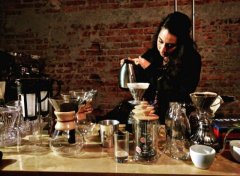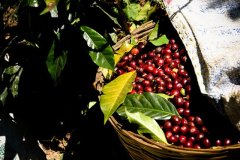Distinguishing HONEY Flavor characteristics of Red Honey, Yellow Honey and Black Honey in Costa Rican Coffee

Professional coffee knowledge exchange more coffee bean information please follow the coffee workshop (Wechat official account cafe_style)
Suggestions on hand punching temperature, grinding degree and powder-to-water ratio of red honey in Tobushi, Costa Rica
Coffee has been rooted in Costa Rica for more than 200 years, and although it is only the third-to-last country in Central America, it is an indispensable role.
At present, Colombia has a total population of about 4.5 million, but there are as many as 400 million coffee trees, and coffee exports account for 25% of the country's total exports. according to local statistics, about 1% of the population is involved in the coffee-related industrial chain. it is not too much to say that coffee has changed the country's living standards.
Costa Rica has a unique natural environment, fertile volcanic ash, mild and suitable temperatures, stable and abundant rainfall, sufficient sunshine during the day, and a significant temperature difference between day and night. Coffee is one of the factors that make coffee a major agricultural product in Costa Rica.
They also produce different grades of raw coffee beans, from commercial Arabica beans to coffee beans from the Outstanding Cup Coffee Competition (COE) to the temple-level geisha coffee variety (Geisha), plus numerous post-processing methods of white, yellow, red and black, which are dazzling.
According to the traditional classification, Costa Rica is divided into seven producing areas, from northwest to southeast, along with the inland central plateau, Western Valley (West Valley), Central Valley (Central Valley), Tarasu (Tarrazu), Sanshui River (Tres Rios), Eurosci Orosi, Brunca, Turrialba, several of which may be familiar to everyone in Taiwan's coffee market, but with the evolution of boutique coffee The norms of large producing areas can no longer satisfy the curiosity of lovers chasing high-quality coffee, resulting in more and more micro-areas and small estates being excavated.
Honey-treated HONEY
Honey treatment, like its name, is more obvious in sweetness.
The honey treatment is to intercept the raw beans washed with water halfway, and not to enter the fermentation process, but directly bring pectin / pulp for exposure. This treatment reduces acidity, increases sweetness and BODY (thickness), also has fruity aromas and improves cleanliness than sun-dried beans.
When we buy coffee beans, we sometimes see coffee bean treatments such as "white honey treatment" or "yellow honey treatment", which depends on how much pectin pulp the raw beans retain after exposure. Exposure with 80% pulp is called "black honey"; with 60% pulp is "red honey"; and retaining 40% pulp is called "yellow honey" treatment; with 20% pulp is called "white honey" treatment. Flavor, with more flesh for exposure, such as black honey red honey, the flavor will be closer to the sun treatment, high sweetness, sufficient fruit aroma, on the contrary, with less pulp, such as white honey treatment, cleanliness will be better, also has a higher sweetness than the general water-washed beans. The common producing countries of honey treatment are located in Central America, Costa Rica or Panama, etc., with good and stable quality. If you want to combine the cleanliness and freshness of washing and the sweetness of the sun, honey treatment is a good choice in your cup.
Important Notice :
前街咖啡 FrontStreet Coffee has moved to new addredd:
FrontStreet Coffee Address: 315,Donghua East Road,GuangZhou
Tel:020 38364473
- Prev

Hand wash Costa Rican red honey-Mozart how to drink Mozart at Carnett Manor, Costa Rica
Professional coffee knowledge exchange more coffee bean information please follow the coffee workshop (Wechat official account cafe_style) Costa Rica Tobushi garden red honey treatment method hand flushing temperature, grinding degree, powder / water ratio suggested coffee: Costa Rica Carnett Manor Mozart red honey treatment roasting degree: medium and shallow roasting day: 2017.08.25 brewing day: 2017.09.05 method: hand grinding powder
- Next

Costa Rican Tara Zhu producing area Coffee processing Coffee from Costa Rica Micro-processing Plant Honey
Professional coffee knowledge exchange more coffee bean information please follow the coffee workshop (Wechat official account cafe_style) Costa Rica Tobushi garden red honey treatment method hand flush temperature, grindness, powder / water ratio it is recommended that Costa Rica is located in the Central American isthmus, while being regulated by Pacific and Atlantic currents and sea breeze on the climate, there are many towering volcanoes up to 2000 meters above sea level.
Related
- Detailed explanation of Jadeite planting Land in Panamanian Jadeite Manor introduction to the grading system of Jadeite competitive bidding, Red bid, Green bid and Rose Summer
- Story of Coffee planting in Brenka region of Costa Rica Stonehenge Manor anaerobic heavy honey treatment of flavor mouth
- What's on the barrel of Blue Mountain Coffee beans?
- Can American coffee also pull flowers? How to use hot American style to pull out a good-looking pattern?
- Can you make a cold extract with coffee beans? What is the right proportion for cold-extracted coffee formula?
- Indonesian PWN Gold Mandrine Coffee Origin Features Flavor How to Chong? Mandolin coffee is American.
- A brief introduction to the flavor characteristics of Brazilian yellow bourbon coffee beans
- What is the effect of different water quality on the flavor of cold-extracted coffee? What kind of water is best for brewing coffee?
- Why do you think of Rose Summer whenever you mention Panamanian coffee?
- Introduction to the characteristics of authentic blue mountain coffee bean producing areas? What is the CIB Coffee Authority in Jamaica?

